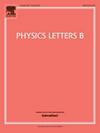Signals from Fermionic inflationary cosmology with Yukawa interaction
IF 4.5
2区 物理与天体物理
Q1 ASTRONOMY & ASTROPHYSICS
引用次数: 0
Abstract
We investigate an inflationary model wherein the Dirac field is directly coupled to a scalar inflaton via a Yukawa interaction and examine the resulting observational implications. Within the slow-roll approximation, we derive analytical solutions of the Dirac equations during inflation. The analytical result on the fermion pair density indicates that the Yukawa interaction strength is to characterize the degree of non-adiabaticity. For large value of the dimensionless effective mass , i.e. , the tensor-to-scalar ratio is suppressed by a factor of approximately . This condition is also characterized by a significant backreaction. Conversely, if , the value of remains consistent with that observed in standard cold inflation. Our analysis is performed under the assumption of the highest inflationary energy scales compatible with current observational constraints.
汤川相互作用下费米子暴胀宇宙学的信号
我们研究了一个暴胀模型,其中狄拉克场ψ直接耦合到一个标量暴胀φ,通过汤川相互作用gϕψ¯并检查由此产生的观测含义。在慢滚近似中,我们导出了膨胀过程中狄拉克方程的解析解。费米子对密度< n >的分析结果表明汤川相互作用强度g是表征非绝热程度的。当无量纲有效质量m≈=(m+ φ)/H较大时,即m≈≈1,张量标量比r被约1/(1+2.95π2g2)的因子抑制。这种情况还具有明显的反作用。相反,如果m ~≪1,r的值与在标准冷膨胀中观察到的值保持一致。我们的分析是在与当前观测约束相容的最高暴胀能量尺度的假设下进行的。
本文章由计算机程序翻译,如有差异,请以英文原文为准。
求助全文
约1分钟内获得全文
求助全文
来源期刊

Physics Letters B
物理-物理:综合
CiteScore
9.10
自引率
6.80%
发文量
647
审稿时长
3 months
期刊介绍:
Physics Letters B ensures the rapid publication of important new results in particle physics, nuclear physics and cosmology. Specialized editors are responsible for contributions in experimental nuclear physics, theoretical nuclear physics, experimental high-energy physics, theoretical high-energy physics, and astrophysics.
 求助内容:
求助内容: 应助结果提醒方式:
应助结果提醒方式:


